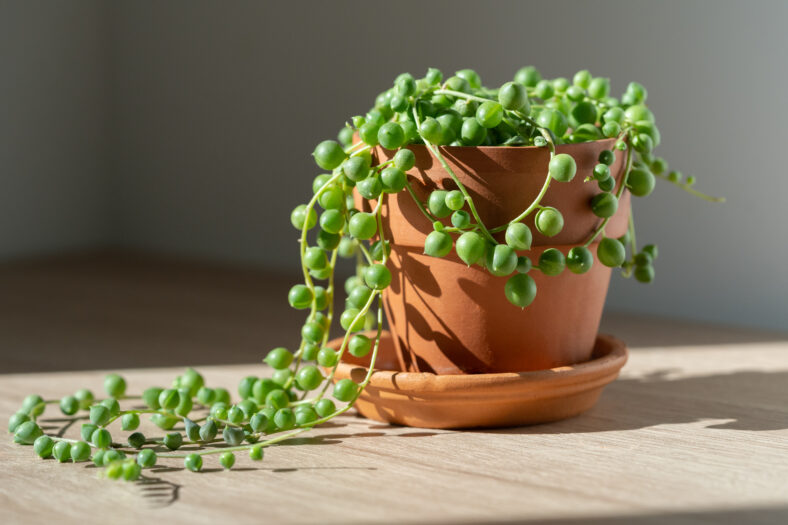How To Care For The Captivating Succulent Known As A String Of Pearls Plant

The string of pearls plant is a captivating succulent known for its stunning and tiny bead-like leaves that cascade from trailing vines.
Native to the arid landscapes of Southwest Africa, this plant usually forms ground cover in its natural habitat. Yet, around the globe, it’s grown as a popular hanging plant that adds a ton of vertical interest and organic greenery to living spaces.
String of pearls has evolved to thrive in harsh environments with minimal water and abundant sunlight, too. So, its adaptability and ease of care make it a favorite among gardeners who love succulents.
If you’re looking to add this unique houseplant to your home, here’s exactly how to care for it.
How To Care For The String Of Pearls Plant
During the spring, summer, and fall, the string of pearls plant thrives in temperatures above 70°F. Then, in the winter, it grows well when temperatures are between 50°F and 60°F.
It also doesn’t like high humidity, so you shouldn’t place it in your bathroom or kitchen. Instead, hanging this plant as an accent point in spaces like your living room or bedroom is the way to go.
When it comes to soil, a standard succulent potting mix will work. However, sandy soil is ideal, and a cactus-specific potting mix is a great choice. You can create your own by combining three parts of potting soil with one part of sharp sand.
Since these plants are prone to root rot, it’s important to make sure the soil drains well. Plus, pick a container that has plenty of drainage holes at the bottom. Terracotta pots are good options, as they help absorb excess moisture from the soil.

Sign up for Chip Chick’s newsletter and get stories like this delivered to your inbox.
Throughout the growing season, you’ll want to provide your string of pearls plant with a balanced liquid fertilizer every two weeks.
Just be sure to dilute it to half the recommended strength. Then, during the dormant winter months, you can cut back on feeding and fertilize every six weeks.
As for light, this plant does best with a mix of direct and indirect sunlight. In total, it should receive between six and eight hours of sunlight each day.
In the morning, you can place it in direct sunlight. Later in the afternoon, move your plant to a location with diffused and indirect light or partial shade to protect it from the midday sun.
Now, your watering schedule will vary depending on the season and climate. In the spring and summer, your string of pearls’ soil should be kept lightly moist, and during the winter months, reduce your watering frequency.
Watering once every seven to 14 days is typically sufficient, but plants grown in warmer climates, porous terracotta pots, or outdoors in the summer may need watering about once a week.
A good rule of thumb is to water when the top half-inch of soil feels dry to the touch. Also, if you realize your plant’s round leaves are starting to flatten, that’s a sign it needs a drink.
When you water, ensure you soak the soil thoroughly until water begins to drain from the pot’s bottom. At the same time, you don’t want to over-water because succulents are drought-tolerant and can’t tolerate soggy roots. Proper drainage is key to keeping your string of pearls happy.
Regular pruning is recommended to encourage your plant to grow fuller and bushier. Use sterilized pruners or scissors to remove any dead pearls or stems. Additionally, if the plant starts to get too overgrown or leggy, you can cut back the longer branches and propagate the cuttings to grow new plants.
Finally, the string of pearls plant can attract common pests, such as mites, aphids, gnats, whiteflies, ants, and mealybugs, especially if the plant is stressed or unhealthy. Factors like high humidity, poor drainage, overcrowding, and lack of light can dull the plant’s natural defenses.
You can prevent infestations by using a neem oil solution to mist your plant, moving it to a well-ventilated area, and avoiding over-watering.
Keep an eye out for pests, and if you spot any of these bugs, you should start with organic treatments like insecticidal soap before resorting to synthetic pesticides.
More About:Gardening





